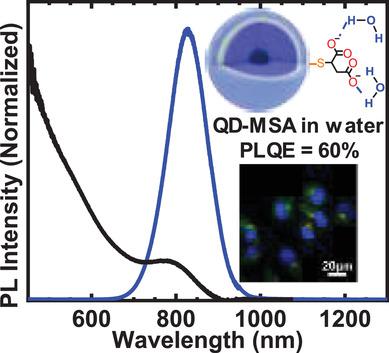当前位置:
X-MOL 学术
›
Adv. Mater. Interfaces
›
论文详情
Our official English website, www.x-mol.net, welcomes your feedback! (Note: you will need to create a separate account there.)
High Quantum Yield Water‐Dispersed Near‐Infrared In(Zn)As–In(Zn)P–GaP–ZnS Quantum Dots with Robust Stability for Bioimaging
Advanced Materials Interfaces ( IF 5.4 ) Pub Date : 2020-09-30 , DOI: 10.1002/admi.202000920 Kang Rui Garrick Lim 1 , Daryl Darwan 1 , Hadhi Wijaya 1 , Zhi Chiaw Lim 1 , Janaki Shanmugam 2 , Tian Wang 1 , Li Jun Lim 1 , Wee Han Ang 1 , Zhi‐Kuang Tan 1, 3
Advanced Materials Interfaces ( IF 5.4 ) Pub Date : 2020-09-30 , DOI: 10.1002/admi.202000920 Kang Rui Garrick Lim 1 , Daryl Darwan 1 , Hadhi Wijaya 1 , Zhi Chiaw Lim 1 , Janaki Shanmugam 2 , Tian Wang 1 , Li Jun Lim 1 , Wee Han Ang 1 , Zhi‐Kuang Tan 1, 3
Affiliation

|
Fluorescent dyes with a high photoluminescence quantum yield (PLQY) and photostability are favored in bioimaging as they offer better imaging signals at lower dye loading, circumventing issues of cytotoxicity and biological pathway interference. Quantum dots (QDs) are efficient emitters with narrow spectral line‐widths, but often employ toxic heavy‐metals, and show significantly diminished PLQY and poor stability after phase‐transfer into aqueous media. Here, the preparation of nontoxic, water‐dispersed giant‐shell In(Zn)As–In(Zn)P–GaP–ZnS QDs that emit in the near‐infrared (NIR) at 828 nm is demonstrated. The QDs exhibit a remarkable PLQY of 75% when initially synthesized in a hydrophobic medium, and retains a high PLQY of 60% after ligand‐exchange and phase‐transfer into water. The water‐dispersed QDs show robust photostability with negligible photoluminescence (PL) attenuation after 3 h of laser irradiation, suggesting that the giant shell is effective in reducing nonradiative recombination that may be caused by photoinduced defects. The water‐dispersed QDs also exhibit high aqueous colloidal stability, retaining a high PLQY of 53% without QD agglomeration after 14 months of storage at 4 °C at a high loading concentration of 20 mg mL−1. The QDs are also successfully incorporated into HeLa cells for confocal bioimaging with no practical signs of cytotoxicity.
中文翻译:

具有高成像稳定性的高量子产率水分散型近红外In(Zn)As–In(Zn)P–GaP–ZnS量子点
具有高光致发光量子产率(PLQY)和光稳定性的荧光染料在生物成像中受到青睐,因为它们以较低的染料负载量提供了更好的成像信号,从而避免了细胞毒性和生物途径干扰的问题。量子点(QD)是有效的发射器,具有窄的谱线宽度,但通常使用有毒的重金属,并且在相转移到水性介质中后,PLQY显着降低,稳定性差。在此,演示了制备无毒,水分散的巨型壳In(Zn)As–In(Zn)P–GaP–ZnS QD的制备方法,它们在828 nm处发射近红外(NIR)。最初在疏水介质中合成时,量子点显示出显着的PLQY达75%,在配体交换并相转移到水中后仍保持60%的高PLQY。水分散的量子点显示出强大的光稳定性,激光照射3小时后光致发光(PL)衰减可忽略不计,这表明巨壳可有效减少由光致缺陷引起的非辐射复合。分散在水中的量子点还表现出高的水胶体稳定性,在20°C的高负载浓度下于4°C储存14个月后,仍保持53%的高PLQY而无量子点结块。-1。量子点也已成功整合到HeLa细胞中,以进行共聚焦生物成像而没有任何细胞毒性迹象。
更新日期:2020-11-21
中文翻译:

具有高成像稳定性的高量子产率水分散型近红外In(Zn)As–In(Zn)P–GaP–ZnS量子点
具有高光致发光量子产率(PLQY)和光稳定性的荧光染料在生物成像中受到青睐,因为它们以较低的染料负载量提供了更好的成像信号,从而避免了细胞毒性和生物途径干扰的问题。量子点(QD)是有效的发射器,具有窄的谱线宽度,但通常使用有毒的重金属,并且在相转移到水性介质中后,PLQY显着降低,稳定性差。在此,演示了制备无毒,水分散的巨型壳In(Zn)As–In(Zn)P–GaP–ZnS QD的制备方法,它们在828 nm处发射近红外(NIR)。最初在疏水介质中合成时,量子点显示出显着的PLQY达75%,在配体交换并相转移到水中后仍保持60%的高PLQY。水分散的量子点显示出强大的光稳定性,激光照射3小时后光致发光(PL)衰减可忽略不计,这表明巨壳可有效减少由光致缺陷引起的非辐射复合。分散在水中的量子点还表现出高的水胶体稳定性,在20°C的高负载浓度下于4°C储存14个月后,仍保持53%的高PLQY而无量子点结块。-1。量子点也已成功整合到HeLa细胞中,以进行共聚焦生物成像而没有任何细胞毒性迹象。



























 京公网安备 11010802027423号
京公网安备 11010802027423号